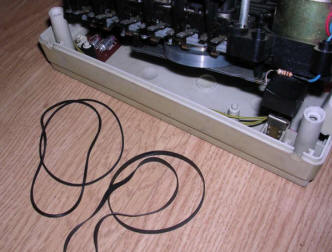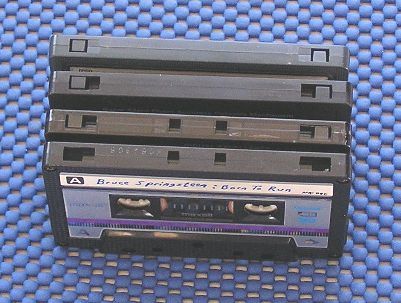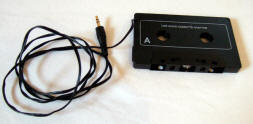Chapter 10: Tape recorders and tapes
Many home microcomputers use casette tapes as a primary medium of storing
programs. You may find them in different conditions. Sometimes you may need to
record own tapes. This chapter will be about them. The procedures of recovering
data from tapes and recording the data back to it on a modern PC varies from
microcomputer to microcomputer, so here will be the general information about
these media.
Tape recorders are mechanical instruments which should
be restored like all other mechanical devices. Clean mechanical part
with brush and check transmission belts because they usually are the
failing parts. Remember to carefully check gears. Plastic ones may have
parts broken off. In some tape recorders like Polish MK 433 or MK 450
polymer used in gears may oxidize. Such oxidized polymer is fragile and
gear looses ith teeth. This problem sometimes happens in some Atari tape
recorders too. Unfortunately there is no easy method of fixing it, gears
can only be replaced. 3D printing of such small components is possible,
but their hardness is not satissfying in most cases.
Check bearings. By rotating the motor check do all functions work
properly and smoothly. If some bearing works hard, consider cleaning it
or adding some lubrication, not too much. Do not apply lubrication on
plastic parts, it usually won't provide better spinning.
Parts which have contact with tape are prone to two kinds of pollution.
First one is pollution by tape remains or dirt, and this can be removed
using alcohol or sometimes even pure window cleaning liquid on a soft
piece of cloth. Just clean front parts of heads, metal bars between them
and all bolts. Clean the shaft to which the rubber roller comes while
playing. Clean the roller too. It is usually very dirty, so do it many
times to make is as dark as possible. Avoid using sandpaper as it will
make the roller surface not flat, this will make the tape not wind
uniformly and may even make the recorder destroy tapes. |

In old tape recorders transmission belts can fail. Here
you can see new and old, stretched belts. |
The second pollution is magnetic residue on heads and metal
parts which have direct contact with tape. To demagnetize it you can use special
demagnetization coil or transformer-based soledring iron (only transformer
based, heater-based don't work). Turn the iron on about 2 meters far from the
recorder, come near, and by circular moves move the heater few centimeters from
heads (press play on a recorder to slide heads into tape deck) slightly blowing
to reduce temperature. After minute or two with the soldering iron still on (DO
NOT TURN IT OFF!) by the same circular moves go about 2 meters away and then
turn it off. This "ritual" is needed because by turning the electromagnet on and
off near heads you may leave heads magnetized some way. When you turn it off few
meters away, you won't leave any magnetic trace.
If the erasing head (the first one which meets tape while playing, usually
pushed only when "record" key is pressed) has no wires connected to it, do not
demagnetize it because in some cheaper recorders erasing head is a permanent
magnet and magnetization of this particular component is needed.
For no way this procedure should be used in high-grade Hi-fi
recorders. Some heads in them should never be demagnetized this way.
Now you can check the recorder with tape. Test playing and
recording. First, leave it on "play" for about 2-3 seconds, stop and remove tape
checking is it wound properly and doesn't go into recorder. The same thing with
rewind, forward, recording.
Now about tapes. There are different types of cassettes:
- Ferro (Iron Oxide), Type I cassettes have brown tape color. They may
wear off quickly. They react terribly on environmental conditions. If you have a
ferro tape which has been flooded or kept in humid environment, recover its
contents and then clean head/roller of your player because in humidity oxide
layer may peel off on head. They are also prone to friction wear - the layer may
wear out by friction of head.
- Chromium Oxide (Type II) tapes are draker, black tapes. They don't react
so badly on environment. They are less prone to stretching or friction, and can
be recorded on most typical recorders.
- Type III is FeCr tapes, they are quite rare and are not widely used.
- Metal (Type IV) tapes are in all colours of rainbow. I've even seen
greenish ones. They need a special tape recorder providing more power in
recording - then metal particles can be magnetized, and they are magnetized
stronger than ferric or chromium tapes. They are usually not used in our
applications.
To distinguish cassette types look at write protection brackets. If there are no
additional holes - it's Iron tape. If there are small holes right near write
protection brackets, pointing to the inside of cassette, this is a Chromium one.
Metal cassettes have additional two holes near the center of the cassette.
In our microcomputer world, we usually never meet metal tapes. Most recordings
are made on Chromium or Ferro tapes. |

On the top, Iron oxide tape. Lower - Chromium tape, Two
lowest tapes are metal-based. Source:
Wikipedia |
There are also 3 phenomena which may prevent you from getting
out the data from the tape:
1. Tape is magnetized, this is the idea of recording. It is always wound
somewhere. In storage one layer may slightly magnetize the other one which is on
it or below it. This makes the sound quality worse. To minimize this problem
always record a tape on your soud card using the highest possible level below
overload.
2. Tape is made of elastic polymer. By stretching it all time during playback or
rewinding, it becomes a bit longer. This makes the recording longer. 3 or 4
seconds per 60 minute tape is not significant for your ear, but matters for the
computer. And you can't do much for it because making the digital recording
speed up in a computer usually makes few bits of data to be stripped off. The
only thing you can do is with the detection algorithm in software which analyses
the sound. For example, in Tape64 software which analyses recordings from
Commodore 64 it is possible to virtually speed the recording up and down by
relatively modifying time coefficients for expecting different signal changes.
3. And the thing you probably won't do anything with: Partial demagnetizations.
Just for 1/10 of second or even shorter the recording level goes down, then agin
up. Tape in this place lost its magnetic properties. Data recorded here is
unfortunately gone. If there is some recording in a significant level, it may be
possible to amplify these places by hand (using time-dependent amplify function
of your wave editor and then specifying the curve), but if the minimal level is
smaller than ca. one third of the normal one data is usually lost.
Sometimes similar behaviour is caused by physical deformation of tape. Rewind
it, then try to record it again. In my restoration sometimes I had to play the
tape 3 or 4 times to get everything off it.
 |
Now a very general information about playing the data to a microcomputer: If you
have a software which allows to export microcomputer programs to WAV files, you
can record them on tape to play in microcomputer, use a tape adapter like these
made for old car players connected to sound card (photo on the left) or, in some cases, connect
sound card's output to microcomputer's tape input. One of common mistakes in
this approach is not taking into account that the sound card may invert the
signal level. The proper option is usually in a program or can be applied in
wave editor. Remember to set the volume to a proper level, because most
microcomputers are picky about it. Any electrical incompatibilities in sound
card's output and computer's input result in more problems with volume
which has to be set exactly to the working level. The same thing is for
recording programs from the microcomputer to a PC's sound card. |
MCbx, 2016



